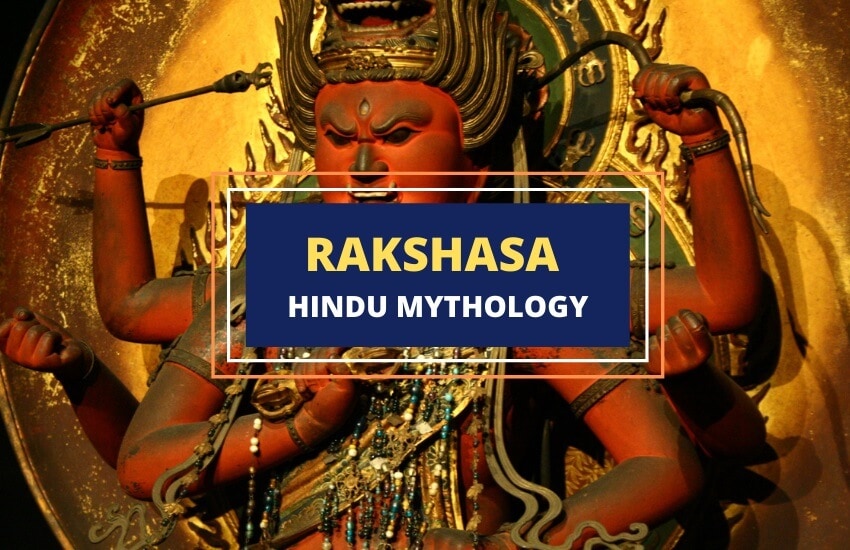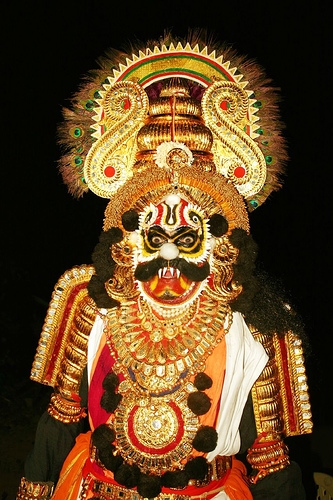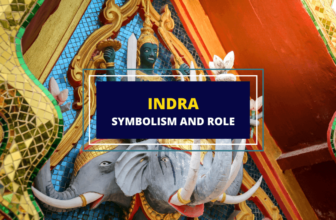
Table of Contents
Rakshasas (male) and rakshasis (female) are supernatural and mythological beings in Hindu mythology. They are also known as Asuras in several regions of the Indian subcontinent. While the majority of the rakshasas are depicted as fierce demons, there are also some beings that are pure at heart and protect the laws of Dharma (duty).
These mythological creatures have several powers, such as the ability to become invisible, or shape-shift. Although they are predominant in Hindu mythology, they have also been assimilated into Buddhist and Jain belief systems. Let’s take a closer look at rakshasas and their role in Indian mythology.

Origins of the Rakshasas
Rakshasas were first mentioned in the tenth mandala or sub-division of the Rig Veda, the most ancient of all Hindu scriptures. The tenth mandala described them as supernatural and cannibalistic beings who consumed raw flesh.
More details on the origins of rakshasas have been provided in later Hindu mythology and Puranic Literature. According to one tale, they were demons who were created from the breath of the sleeping Brahma. After they were born, the young demons began to crave for flesh and blood, and attacked the creator god. Brahma defended himself by saying Rakshama, which meant, Protect Me, in Sanskrit.
Lord Vishnu heard Brahma saying this word and came to his aid. He then banished the rakshasas from heaven and into the mortal world.
Characteristics of Rakshasas
Rakshasas are large, heavy, and strong beings with sharp claws and fangs. They are depicted with fierce eyes and flaming red hair. They can either become completely invisible, or shape-shift into animals and beautiful women.
A rakshasa can smell human blood from far away, and their favourite meal is raw flesh. They drink blood either by cupping their palms, or directly from a human skull.
They have incredible strength and endurance, and can fly for several miles without stopping to take a break.
Rakshasas in the Ramayana
Rakshasa’s played a very important role in the Ramayana, a Hindu heroic epic written by Valmiki. They directly and indirectly influenced the plot, story, and events of the epic. Let’s take a closer look at some of the most important rakshasa’s in the Ramayana.
Shurpanaka
Shurpanaka was a rakshasi, and the sister of Ravana, the king of Lanka. She witnessed Prince Ram in a forest, and immediately fell in love with his good looks. Ram, however, rejected her advances because he was already married to Sita.
Shurpanaka then attempted to marry Lakshmana, the brother of Ram, but he too refused. Out of anger at both the rejections, Shurpanaka tried to kill and destroy Sita. Lakshmana, however, thwarted her attempts by cutting of her nose.
The demoness then went back to Lanka and reported this incident to Ravana. The king of Lanka then decided to avenge his sister by kidnapping Sita. Shurpanaka indirectly instigated Ravana, and caused the war between Ayodhya and Lanka.
Vibhishana
Vibhishana was a brave rakshasa, and Ravana’s younger brother. Unlike Ravana, however, Vibhishana was pure at heart and ventured on the path of righteousness. He was even granted a boon by the creator god Brahma. Vibhishana helped Ram in defeating Ravana and getting back Sita. After Ravana was slain, he ascended the throne as the king of Lanka.
Kumbhakarna
Kumbhakarna was an evil rakshasa, and a brother of king Ravana. Unlike Vibhishana, he didn’t venture on the path of righteousness, and indulged in materialistic pleasures. He requested Brahma for the boon of everlasting sleep.
Kumbhakarna was a fearsome warrior and fought alongside Ravana in the battle against Ram. During the battle, he attempted to destroy Rama’s monkey allies, and even attacked their king, Sugriva. Rama and his brother Lakshmana, however, used their secret weapon and defeated the evil Kumbhakarna.
Rakshasas in the Mahabharata
In the epic of Mahabharata, Bhima had several confrontations with rakshasas. His victory over them turned him into a highly respected and venerated Pandava hero. Let’s look at how Bhima confronted and defeated the evil rakshasas.
Bhima and Hidimba
A rakshasa called Hidimba came across the Pandava brothers when they were residing in a forest. This cannibalistic rakshasa wanted to consume the flesh of the Pandavas, and sent his sister to persuade them.
Unexpectedly, Hidimbi fell in love with Bhima, and spent the night with him. She then refused to allow her brother to harm the Pandava brothers. Enraged at her betrayal, Hidimba ventured to kill his sister. But Bhima came to her rescue and eventually slew him. Later on, Bhima and Hidimbi had a son called Ghatotkacha, who greatly assisted the Pandavas during the Kurukshetra war.
Bhima and Bakasura
Bakasura was a cannibalistic forest Rakshasa, who terrorized the people of a village. He demanded to be fed with human flesh and blood on a daily basis. The people of the village were too scared to confront and challenge him.
One day, Bhima came to the village and decided to take food for the Rakshasa. However, on the way, Bhima himself ate the meal, and met Bakasura empty handed. An enraged Bakasura engaged in a dual with Bhima and was defeated.
Bhima had broken the Rakshasa’s back and made him beg for mercy. Ever since Bhima visited the village, Bakasura and his minions caused no more trouble, and even gave up their cannibalistic diet.
Jatasura
Jatasura was a cunning and allusive Rakshasa, who disguised himself as a Brahmin. He attempted to steal the Pandavas’ secret weapons, and sought to destroy Draupadi, the favourite wife of the Pandavas. However, before any harm could be done to Draupadi, the valiant Bhima intervened and slew Jatasur.
Rakshasas in the Bhagavata Purana
A Hindu scripture known as the Bhagavata Purana, narrates the story of Lord Krishna and rakshasi Putana. The evil king Kamsa orders Putana to kill an infant Krishna. The king is afraid of a prophecy that foretells his destruction by the son of Devaki and Vasudeva.
Putana disguises herself as a beautiful woman and ventures to breast feed Krishna. Before doing this, she poisons her nipples with the venom of a deadly snake. To her surprise, as she feeds the child, it feels like her life is being slowly sucked out. To everyone’s astonishment, the Krishna kills the rakshasi and plays on top of her body.
Rakshasas in Buddhism
A Buddhist text known as the Mahāyāna, narrates a conversation between Buddha and a group of rakshasa daughters. The daughters promise Buddha that they will uphold and protect the doctrine of the Lotus Sutra. They also assure Buddha that they will teach protective magical chants to the followers who uphold the sutra. In this text, the Rakshasa daughters are seen as the upholders of spiritual values and dharma.
Rakshasa’s in Jainism
Rakshasa’s are seen in a very positive light in Jainism. According to Jain scriptures and Literature, Rakshasa was a civilized kingdom that consisted of the people of Vidyadhara. These people were pure in thoughts, and vegetarians by choice, as they didn’t want to harm any animals. As opposed to Hinduism, Jainism looked at rakshasa’s with a positive perspective, as a group of people with noble characteristics and values.
In Brief
In Hindu mythology, rakshasas are both the antagonists and allies of gods and goddesses. They play a significant role in the story and plot of the ancient Hindu epics. In contemporary times, many feminist scholars have re-imagined the rakshasas and have portrayed them as victims of a cruel and hierarchical social order.








